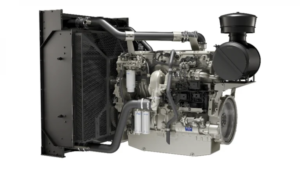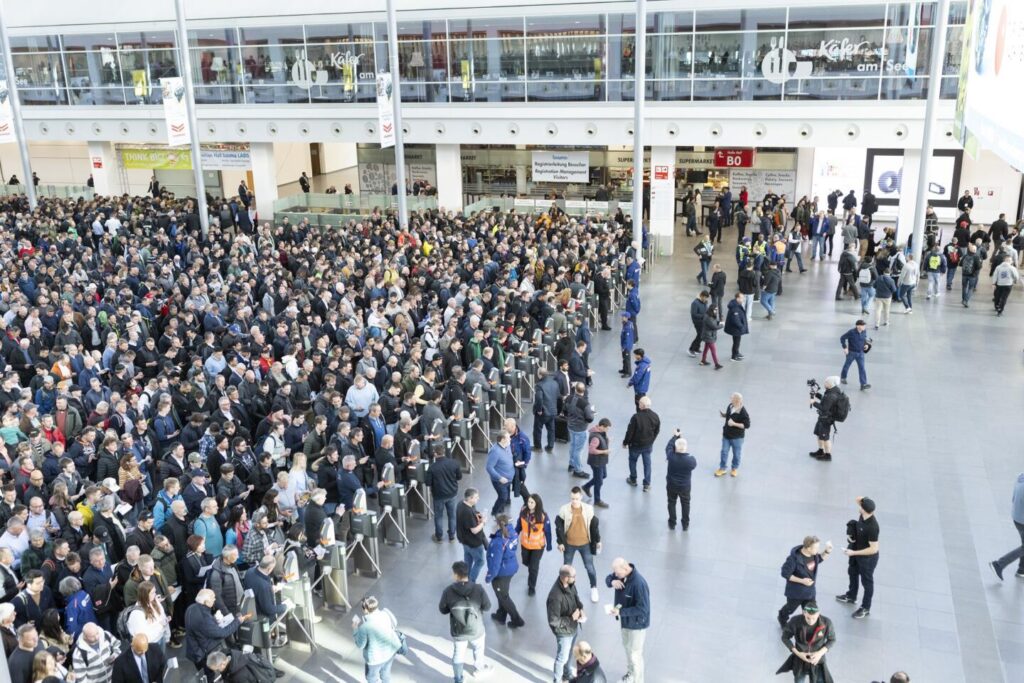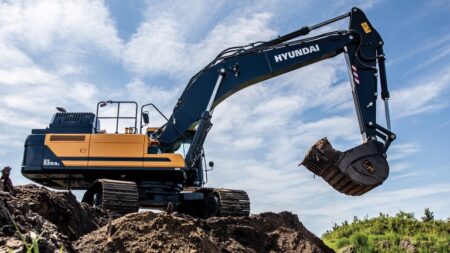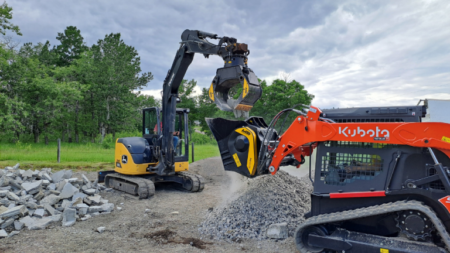An aerial view of the sprawling Bauma 2025 fairgrounds in Munich, where construction machinery rises like a steel city.
I had a chance to be at the forefront of Bauma 2025, a beautiful event that cemented its reputation as the ultimate playground for construction and mining technology. With around 600,000 visitors flooding in from over 200 countries, the week-long spectacle nearly matched its pre-pandemic record attendance . For those of us on the ground, the atmosphere was electric – part global summit, part carnival. Tower cranes etched the skyline, hydraulic arms waved in choreographed motion, and languages from every corner of the world mingled in the aisles. As one industry veteran exclaimed, the seven days of Bauma are “a pure adrenaline rush… the best sales platform in the world”. This year’s edition was exceptionally organised (as only Germany can do), yet it felt like a thrilling sandbox of innovation – a place where multi-ton machines and cutting-edge tech converged to make the future tangible.
Below, I break down the 6 key themes that emerged from Bauma 2025
1 -Real-World Tech Revolution: The Future Is Now
Not long ago, talk of fully autonomous excavators, AI-guided cranes, or “digital twin” construction sites seemed like distant hype. At Bauma 2025, those visions stepped off the PowerPoint slides and onto the show floor. The revolution in construction tech has well and truly arrived. Many breakthrough technologies that felt futuristic in the last Bauma are now operational and market-ready, making this show feel like a sci-fi sequel set in the present day.
Wandering through the halls, I watched a dozer navigate an obstacle course with no operator in the cab, sensors and GPUS doing the heavy thinking. Nearby, drones mapped a live construction site model on a big screen in real time, and a demo of an excavator operated remotely via VR goggles drew constant crowds. The buzzwords of past years – automation, connectivity, digitalization – were no longer just buzz. They were everywhere, embedded in iron and steel. In fact, discussions with exhibitors consistently centered on these now-mainstream trends of automation and digital jobsite tech. One executive noted that “at Bauma, we showcased drive technology and autonomy… the platform where the future of the industry is made tangible” – and he meant it literally. From smart hydraulic systems that self-adjust on the fly to drills that learn from data, the emphasis was on tangible tools pushing boundaries of performance.
Not just concept vehicles
Several examples made it clear how far things have come since the last Bauma. In 2019, attendees marvelled at a handful of electric mini-excavators and early telematics dashboards. Fast forward to 2025: an entire haulage convoy was driving itself in a demo yard, and fully electric equipment lines were prominent at many stands. One major manufacturer even displayed only electric machines on its stand – a bold statement that the era of emission-free equipment is truly here . Another exhibitor launched a new global telematics platform integrating IoT, cloud analytics and AI, capable of orchestrating fleets across continents in real time. All these breakthroughs share a common trait: they’re not science experiments or one-off prototypes, but market-ready solutions. The real world tech revolution has graduated from concept to commercialization, and Bauma 2025 was its coming-out party.
2 -The Operator 2.0: From Hard Hat to Data Helmet
Amid this automation surge, a fascinating narrative at Bauma 2025 was the evolving role of the human operator – what some are calling “Operator 2.0.” Rather than being sidelined by smart machines, tomorrow’s operators are transforming into a new hybrid: part skilled heavy-equipment driver, part data analyst and mission controller.
Picture a future worksite where a handful of multi-skilled supervisors oversee swarms of semi-autonomous machines. That vision was on display in Munich. I stepped into one OEM’s futuristic command cab – more spaceship cockpit than earthmover – complete with joysticks, touchscreens, and real-time lidar feeds of multiple machines on a virtual site. The idea is that an operator 2.0 might sit in a comfortable control room (or even off-site), managing and mentoring an army of robots doing the dirty work. A few companies even demonstrated “platooning” concepts – one operator driving a lead vehicle and others behind following autonomously like well-trained ducklings.
What does this shift mean for the people in these jobs? For one, training is paramount. The next-gen operator needs a toolbelt that includes not just wrenches and grease guns, but software savvy and analytical skills. Semi-autonomus equipment is taking over repetitive or precise motions, but human oversight and decision-making are still critical. As Hitachi’s team noted, the industry is increasingly relying on digital assistance systems and partial automation, “in addition to appropriate training for machine operators”. In other words, the operator’s role is evolving into a higher-level supervisor of processes, one who can interpret data, tweak algorithms on the fly, and step in when judgment calls are needed. This could boost productivity – imagine one person orchestrating three or four machines at once – but it also means a reskilling challenge. Conversations at Bauma often touched on the need for simulators, VR training, and new certification programs to prepare staff for this hybrid role.
There was palpable excitement about how Operator 2.0 could elevate safety and efficiency. Autonomous machines don’t get tired or distracted, and removing people from trenches or quarry blasts improves safety. Yet, the human touch remains the “secret sauce” for adaptability on unpredictable job sites. One veteran operator I spoke with likened it to an orchestra: “The machines are all automated instruments, but you still need a conductor.” That conductor now wields tablets and data dashboards as much as levers. If Bauma 2025 was any indication, the cabs of the future may be empty, but the role of the operator will be more important – and more skilled – than ever: at the end, he will be a sort of data analyst in action
3-Power Source Diversity: OEMs Ready, Clients Not Yet
Never before have we seen such powertrain diversity on display. Diesel engines, the longtime workhorses of construction, stood proudly side by side with battery packs, hydrogen fuel cells, hydrogen combustion, and even alternative fuels like HVO (hydrotreated vegetable oil) in the spotlight. The message was clear: there’s no one-size-fits-all solution for powering machinery in the coming decades, so the industry is hedging its bets with a variety of energy options.
Diesel isn’t dead – far from it. Many experts noted that for the highest-demand applications, diesel will remain dominant for years (Bosch forecasts that 4 out of 5 new heavy machines will still have diesel engines in 2035) . The difference is today’s diesels are cleaner and often biofuel-compatible. Several exhibitors highlighted engines tuned to run on HVO or other synthetic fuels to cut carbon without sacrificing performance, effectively giving these brutes a greener diet . At one booth, I saw a massive next-gen diesel engine with a sign bragging it could burn biodiesel and even hydrogen blends – showing that the old dog is learning new tricks.
Mining is shifting to electric, construction not
Entire ranges of electric compact equipment – from mini-excavators to wheel loaders – were available, many touted as “production-ready.” One global OEM’s stand featured only electric models, underscoring confidence in battery power for a broad swath of machinery . In the mining sector, electrification is already rewriting the rulebook. Attendees gaped at a 240-ton mining haul truck quietly cruising around under battery power and a 350-tonne mining excavator powered via a 300-meter tethered cable, performing heavy digs with zero emissions. In those environments, electric drives have huge appeal – cutting ventilation costs underground and eliminating diesel particulate in sensitive areas.
It’s no surprise that many in mining say their future fleets will be largely electric.
In general construction, the technology is now available – you can buy an electric digger or concrete truck today – yet customer uptake lags behind the hype. Why? The consensus at Bauma was that cost and infrastructure remain the big sticking points. A recent industry analysis bluntly stated that despite all the shiny battery-powered equipment on show, “high purchase prices, a lack of charging infrastructure and technical challenges are acting as barriers to take-up” . Contractors are intrigued by electric machines (especially for their quiet operation and environmental benefits), but many aren’t ready to swallow the price premium or figure out charging for a whole fleet. As one rental company manager told me, “We love the idea, but the ROI math has to work.” Until battery costs come down and fast-charging or swapping networks spread, diesel will still rule many a jobsite.
Even so, the progress since Bauma 2022 is striking – back then electrics were a curiosity; now they’re a core offering, just awaiting broader customer buy-in.
Hydrogen is the other hot contender in the power mix. At Bauma 2025, hydrogen fuel cells and combustion engines made a splash as the potential solution for heavy, long-duty-cycle machines where batteries might be impractical. Several stands showcased hydrogen combustion engines that looked almost identical to diesels – and that’s by design. Engineers boast that “around 80% of the technology can be transferred from conventional engines” to hydrogen , meaning manufacturers can repurpose proven designs.
Ultimately, Bauma 2025 highlighted that the future of equipment power is a mix-and-match game. Diesel, electric, hydrogen, hybrid combinations – all are in play, each suited to different use cases. A mining company might run a fleet of battery trucks and cable-fed excavators, while a highway contractor sticks with Stage V diesels running on biofuel, and a city contractor embraces electric mini-loaders for zero-emission urban work. The good news: the industry has never had more choices. The challenge will be aligning those choices with real-world needs and economics. Which brings us to the next theme: making the business case in a cooling market.
4 – Sales Sentiment: Euphoria Drops, Optimism Endures:
If the aisles of Bauma 2019 were filled with unbridled euphoria (booming sales, giant backlogs, champagne toasts to record years), the mood in 2025 was a bit more measured – a blend of pragmatism and cautious optimism. Market dynamics have shifted. After several years of red-hot growth and pandemic recovery stimulus, the construction equipment market has been moderating. In Europe, 2024 saw a notable slowdown – a 19% drop in equipment sales – driven by high costs, inflation and geopolitical jitters. Coming into Bauma, many expected a cooler vibe reflecting those headwinds.
Indeed, behind the gleaming machines, conversations acknowledged that the days of frenzy have calmed. Order books aren’t quite as flush as a couple of years ago, and some segments (like general construction) are experiencing a breather. However, “moderation” is far from “turmoil.” Underlying optimism ran strong throughout the Munich fairgrounds. Corporate leaders I spoke with were upbeat, often surprisingly so. “We were delighted with the positive atmosphere… which we hadn’t expected in this form,” said one equipment manufacturing executive, adding that Bauma 2025 could spark a “positive stimulus for a revival” in the construction sector. That sentiment – cautious hope – permeated many discussions. The consensus seemed to be that while growth might plateau in the short term, the long-term trajectory (fueled by infrastructure needs, green initiatives, and pent-up demand in emerging markets) remains promising. As evidence, many companies reported strong engagement at their booths and even better-than-expected order intakes, defying the gloomier forecasts.
One recurring topic was the cloud of international trade tensions, particularly the U.S. tariffs on European goods that have been lingering since the last administration. “Trump’s tariffs” was literally the talk of the show for many OEM executives. The uncertainty around these tariffs – whether they’ll be lifted or morph into something else – has everyone in a bit of a “wait and see” mode . European manufacturers, who count the U.S. as a huge export market, are understandably anxious. At Bauma, some revealed contingency plans: for example, one major European OEM is accelerating construction of a factory in the U.S. so it can build certain machines stateside and bypass the tariff risk. “Localise production” was a refrain, as companies strategize to hedge against trade barriers. An economic report launched during the show even suggested that a flat market in Europe for 2025 would be a victory after the 2024 dip, given these uncertainties.
5 – Chinese Brands Ready to Shake the European Market
Yet, where uncertainty exists, so do new opportunities. A subtext to the tariff chatter was the potential opening for Chinese OEMs in Europe. If North America becomes trickier for European firms, attention may pivot to other regions – and Chinese manufacturers are eagerly vying for a bigger slice of the European pie. Bauma 2025 saw a notable increase in Chinese presence, both in terms of exhibitors and visitors, compared to previous editions . Several large Chinese equipment makers had some of the most buzzed-about exhibits of the show. One leading Chinese company, for instance, unveiled over 60 new machines for the European market, many of them “green and intelligent” models geared to European sustainability trends . It’s clear that Chinese brands see any gap left by others as their chance to expand. European attendees, for their part, showed genuine interest in these offerings, especially as quality and tech levels from Asia continue to rise. If U.S.-EU trade issues linger, we could indeed see a scenario where Chinese OEMs make deeper inroads in Europe, bringing competitive pressure but also new partnerships. As one insider quipped, “the big winner of the tariff war might just be wearing Made in China.” Time will tell.
In summary, the sales sentiment at Bauma 2025 can be characterized as “optimism in check.” The industry has come down from its sugar high of the late 2010s and post-lockdown boom, but it’s on very solid footing. Construction and mining aren’t going away – if anything, the coming green transition and infrastructure investments will require more equipment, not less. The vibe in Munich was that of a sector catching its breath, adjusting to new realities (like trade shifts and higher interest rates), yet fundamentally confident about the road ahead. And Bauma itself, with its throngs of buyers and deals being struck on the stands, was proof that even in moderated times, there’s plenty of excitement to go around.
6 – Sustainability with a Price Tag: Can We Afford It?
If one theme wove through every hall at Bauma 2025, it was sustainability. Not as a token buzzword or a painted-green show machine, but as an integral design principle in nearly all new equipment. The industry has clearly moved sustainability from the margins to the mainstream – it’s now baked into the DNA of next-gen machines. From energy efficiency to emissions reduction and recyclability, green thinking was evident in everything on display. However, a candid undercurrent to this theme was the question of cost and affordability. The shiny, sustainable solutions are technically ready for prime time, but are customers ready (and able) to pay the premium that often comes with them?
On the one hand, it’s incredible how far eco-friendly design has come. Manufacturers big and small showcased equipment that dramatically cuts CO₂ emissions and other pollutants. Many proudly pointed out that they’ve achieved these gains without sacrificing performance – a huge shift from a decade ago when “green” often meant “underpowered” or “experimental.” As one organizer’s report highlighted, corporate decision-makers at Bauma universally emphasized the importance of sustainability and its role in driving progress . In practical terms, that meant countless examples of innovation: hybrid engines that shut off at idle, hydraulic systems using biodegradable fluids, components made of high-strength lightweight materials (to save fuel), and of course all those electric and hydrogen machines discussed earlier. The consensus is that sustainability is no longer an optional add-on; it’s a core requirement in modern equipment design. One could say “green is the new default.”
But noble intentions meet hard economics in the real world. The price tag of sustainability was a hot topic in many conversations. A contractor admiring an electric crane would next be heard grumbling about the cost. A mining engineer excited about cutting diesel use would then admit the infrastructure for charging was a major investment. The Roland Berger analysis making rounds bluntly projected that a true explosion in battery-electric construction equipment likely won’t happen until the 2030s, precisely because of high costs and infrastructure needs in the 2020s . It’s a classic Catch-22: volume would drive prices down, but until prices drop, volume won’t ramp up. Likewise, sustainable fuels and systems often require new supply chains or training that add to upfront costs. As one rental fleet manager sighed, “We want to be sustainable, but someone has to foot the bill – and right now that’s unclear.”
So, how are OEMs addressing this affordability gap? A few strategies were evident at Bauma:
-
Total Cost of Ownership (TCO) Pitch: Nearly every sales rep now comes armed with calculators and case studies to argue that the lifetime cost of green equipment is lower, even if the purchase price is higher. For instance, more efficient machines burn less fuel (or electricity), which lowers operating costs. A great example was the focus on optimizing hydraulics – by making hydraulics more efficient, one exhibitor noted, you cut energy use and extend battery runtime, directly saving money for owners . These efficiency gains mean fuel savings and less downtime, which can help offset that initial investment. Many stands had side-by-side comparisons showing that over X years, the electric or hybrid model comes out ahead financially thanks to lower energy and maintenance expenses.
-
Modularity and Retrofits: To ease the cost of transitioning to new tech, some OEMs are designing machines to be modular. Think swap-in battery packs, or diesel-to-hydrogen conversion kits, so a customer could upgrade the powertrain later without buying an entirely new machine. This approach protects the customer’s investment and spreads out costs. While still emerging, the concept got a lot of nods from attendees interested in “future-proof” equipment.
-
Industry Collaboration: Perhaps the most heartening approach to tackling costs is companies teaming up. A prime example is the Battery One initiative – several manufacturers have created a universal, interchangeable battery system for compact equipment . By sharing a common battery format, a contractor can invest in a set of batteries and use them across multiple brands and tools. “A multi-vendor interchangeable battery is key to growing adoption… it lowers equipment and infrastructure costs,” explained one participating executive . In other words, collaboration is being used to achieve economies of scale that no single OEM could reach alone. This not only drives down cost per unit, but also gives customers confidence that their expensive battery assets won’t become obsolete or orphaned. We also saw partnerships in areas like charging stations and hydrogen fuel supply – joint efforts to build the ecosystem needed to support the sustainable tech. Such collaborative moves are critical to make green solutions economically viable and convenient for end-users.
-
Incentives and Policy Support: Though not something manufacturers directly control, many folks at Bauma mentioned government incentives as part of the affordability puzzle. Subsidies, tax breaks, or low-interest “green financing” can tip the scales to make a sustainable machine cheaper in effective cost. European climate policy is pushing in this direction, but industry players are actively lobbying for more support to help customers go green sooner. One can imagine future Bauma editions where financing programs are as much a draw as the machines themselves.
The bottom line is, sustainability is here to stay – every company at Bauma 2025 made that clear through their products. The remaining hurdle is ensuring these solutions are accessible to the average buyer. As an industry, there’s recognition that being “eco-friendly” is not enough; it also must be “wallet-friendly.” That reality is spurring clever approaches to reduce costs, from technical innovations to new business models. It’s a work in progress, but the trajectory is positive. If the technical leaps of the past few years are any indication, the next challenge to solve is scaling and affordability – and the sense in Munich was that the innovators are on it.
The Bauma Experience: Where Industry is the Show
No review of Bauma 2025 would be complete without talking about the experience of the show itself. For those who have never been, imagine the world’s biggest playground for construction: an area the size of 86 football fields packed with towering equipment, buzzing demo pits, and pavilions throbbing with business deals and tech demos. It’s part trade fair, part festival. And after the disruptions of recent years, Bauma returned in 2025 with a vengeance – bigger, busier, and more exuberant than ever.
Each morning, throngs of attendees lined up at the gates, the excitement palpable (and caffeinated). Over 3,600 exhibitors from 57 countries vied for attention , and the show layout was a maze of discovery. One moment you’re standing under the shadow of a 50-meter tall crane, the next you’re petting a robo-dog that inspects tunnels. The sounds of Bauma are a symphony: engines revving, hydraulic pumps whirring, occasional cheers as a particularly impressive stunt is performed (yes, some booths treated visitors to choreographed machine “dances” and even an occasional excavator bucket beer toast). Organization was top-notch – despite the massive scale, everything from shuttle transport to hall signage ran like clockwork. Seasoned attendees remarked how smooth it was to navigate compared to some other global shows. Messe München truly knows how to host an event of this magnitude, and it showed.
The international flavor is a huge part of the Bauma magic. Strolling from one hall to the next felt like traversing continents. You’d hear Italian, Chinese, Spanish, and English all in the span of a few steps. Delegations from emerging markets rubbed shoulders with European rental firms and American contractors. Notably, the 2025 show saw more global visitors than ever, with significant upticks from places like Brazil and Turkey, and especially China . It’s the ultimate melting pot for the industry – a place where an Australian mining engineer can chat up a Finnish attachment maker and strike a deal over pretzels and beer. The global scale not only makes for rich networking, but also ensures Bauma is where trends truly go worldwide. A technology unveiled here one day might find its way to a remote jobsite on the other side of the globe next month.
Bauma is also where industry meets spectacle. Each exhibitor tries to outdo the next in grabbing attention. In past years we’ve seen everything from a ferris wheel giving rides above the equipment yard to life-sized simulators that let you feel what it’s like to operate a giant machine. 2025 had its share of crowd-pleasers: an automation company’s booth featured a live show of synchronized mini-dump trucks performing a “ballet” (yes, really), and at least one stand had a VR crane game where participants could win model machines. These fun touches make Bauma enjoyable, not just important. As a journalist, I find it delightful that you can have a serious discussion about carbon reduction one minute, then go watch a stunt show with excavators the next. It’s a reminder that this industry, for all its seriousness, has a passionate heart – people truly love these machines and what they do.
Perhaps the most defining aspect of Bauma is the energy of innovation and partnership that saturates the event. Deals are made, yes, but it’s also about exchanging ideas. “Bauma is the heartbeat of the industry,” the organizer’s CEO said , and that metaphor feels apt. Over the week, you can practically see the pulse of progress – companies announcing collaborations, researchers sharing breakthroughs in the forums, young engineers wide-eyed at their first Bauma getting inspired by the sheer scale of possibility. One CEO of a major equipment firm was quoted saying the show is “an adrenaline rush” and an unbeatable platform where the whole industry comes together . After spending a week immersed in it, I wholeheartedly agree. Nowhere else will you find such concentration of knowledge, equipment, and enthusiasm in this field.
Walking away from the fairgrounds (feet sore, notebook full, mind racing with new ideas), I’m struck by how far we’ve come since the last edition and how quickly things will likely evolve by the next. By Bauma 2028, who knows what marvels will be on display? If the pace of change since 2022 is any indicator, we’ll see even more autonomy, perhaps whole fleets of zero-emission vehicles, and roles like the Operator 2.0 will be commonplace.
One thing is certain: Bauma will still be Bauma – the defining event where this industry shows off its best and dreams out loud. It’s more than an exhibition; it’s a bellwether and a celebration. As I left the Munich grounds, the sun setting behind a forest of cranes, I couldn’t help but smile. The future of construction and mining was not just being imagined – it was being lived, right here, right now, at Bauma 2025.
And it looked incredibly bright, sustainable, and yes, even a little bit fun.
Read the full article here











